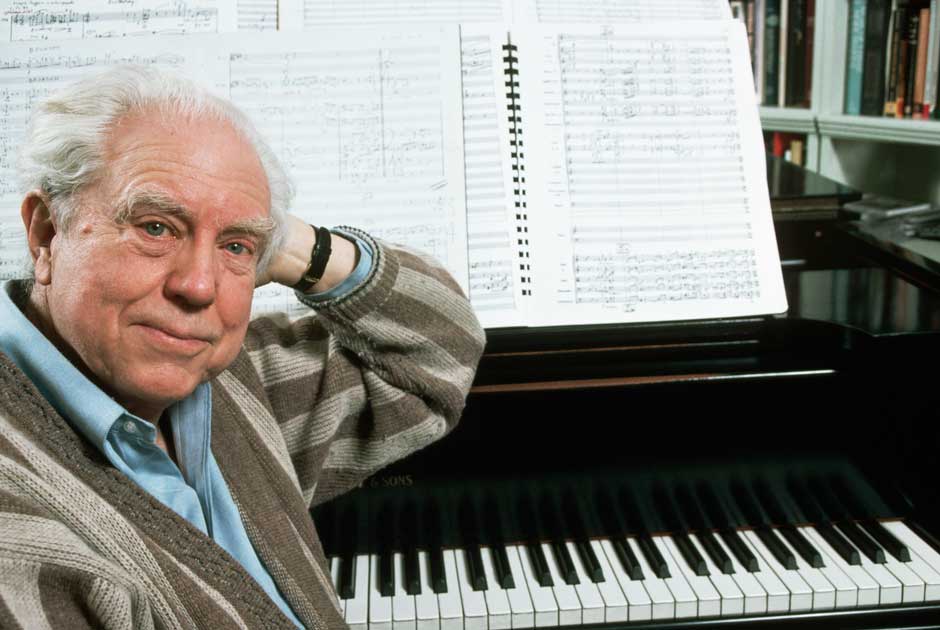It is now just a year since the death of the composer Elliott Carter and his absence still seems a little unreal. He lived a very long life—he died thirty-six days before his one hundred and fourth birthday—and he remained active up to the end, creating some of the warmest, most direct and intimate music of his career in his final years. Such longevity in itself is astounding: think of long-lived composers like Giuseppe Verdi, Richard Strauss, and Jean Sibelius, and then consider that all of them were either dead or retired at the point when Carter was embarking on his first and only opera, What’s Next?, at the age of eighty-eight, with another fifteen years of work yet ahead of him.
In most cases, a composer’s stock goes down after death, at least for a while (two exceptions that come to mind are Virgil Thomson and Morton Feldman). The works of Wallingford Riegger and Roger Sessions are rarely heard today, although both men were powerful and inventive modernist composers, occasionally grouped with Carter, and their deaths were deemed significant enough to be reported on the front page of the next day’s New York Times. Carter, who came into prominence in the 1950s alongside composers like Boulez, Stockhausen, and Berio, was never exactly a “popular” composer, but he was invariably a respected one—perhaps the respected one in the last quarter of the twentieth century—and those who loved his music found it like nothing else in the world. If I were to wager on posterity, he would seem a safe and honorable bet.
The composer David Schiff, whose own work sounds nothing like that of Carter but who is a former student and articulate devotee, once observed that Carter made music out of “simultaneous oppositions.” “A piano accelerates to a flickering tremolo as a harpsichord slows to silence,” Schiff wrote in his book The Music of Elliott Carter. “Second violin and viola, half of a quartet, sound cold, mechanical pulses, while first violin and cello, the remaining duo, play with intense expressive passion. Two, three or four orchestras superimpose clashing, unrelated sounds. A bass lyrically declaims classical Greek against a mezzo-soprano’s American patter.”
Such a list could be continued for paragraphs. Carter wrote music that rewarded deepest concentration. His audience didn’t come to relax or to “lose itself” in his music; on the contrary, it came for a bracing and mercurial charge, as visceral as it was brainy.
Carter’s early compositions, such as the ballet Pocahontas (1939), call to mind some of Aaron Copland’s more deliberately “Americanist” works (in this case, right down to the choice of topic). In tribute to two of the contemporary creators he found most influential, he suggested that the players in his Cello Sonata (1948) keep separate ideals in mind—the cellist playing in the so-called “atonal” language of Arnold Schoenberg, the pianist staying closer to the neo-classicism of Igor Stravinsky. The fact that these composers were then considered aesthetic antipodes did not seem to bother him. Indeed, he was always fascinated by mixtures, and he was deeply admiring of the alternately strict and variable rhythms he found in the jazz music of Art Tatum and Fats Waller.
The String Quartet No. 1 (1951), which made Carter’s international reputation, is a spacious, mysteriously unified one-movement piece that was created in the Arizona desert and somehow sounds that way, with its long vistas broken up by volatile events and activities—the violent writing for viola and cello set against the muted violins, for example. In the String Quartet No. 2 (1959) Carter endowed the instruments with markedly different characters. He called the music he wrote for first violin “fantastic, ornate and mercurial” while the second violin was provided with “laconic and orderly” material. The music he wrote for the viola was, he said, simply “expressive” and that for the cello, “somewhat impetuous.”
This was the direct opposite of Johann Wolfgang von Goethe’s description of chamber music as a “discourse between reasonable individuals.” The individuals were there, to be sure, but this was no chaste, aristocratic “discourse.” The nerve endings were alive: all was strain, fury, argument and at the end, perhaps, a sort of half-hearted reconciliation. Three further string quartets were to come, the last of them in 1995.
The title of A Symphony of Three Orchestras (1976) is misleading—in fact, the 15-minute symphony, inspired by the poetry of Hart Crane, is scored for one large orchestra divided into three. One of Carter’s most popular creations, it makes its strongest impression in concert, where one may listen to each ensemble playing its own allotted music, then combining with the other ensembles to create a cumulative whole. The Night Fantasies (1980) had an almost Schumann-like quality: here was a true pianistic neo-romanticism, impulsive and intuitive music that looks forward instead of wallowing once more in nineteenth-century harmonies.
Advertisement
Looking backward in repose was never one of his interests. On the contrary, Carter was a true Modernist. “I just can’t bring myself to do something that someone else has done before,” he said. “Each piece is a kind of crisis in my life.” May we be grateful for such crises.



